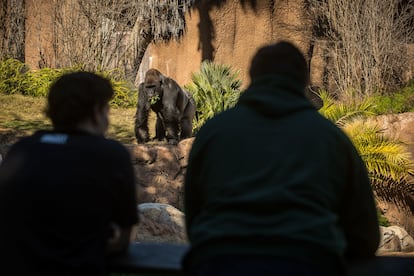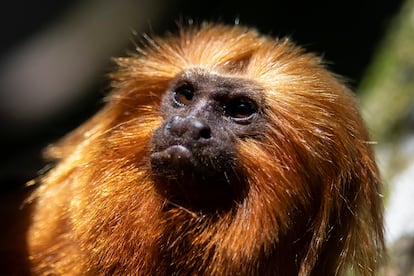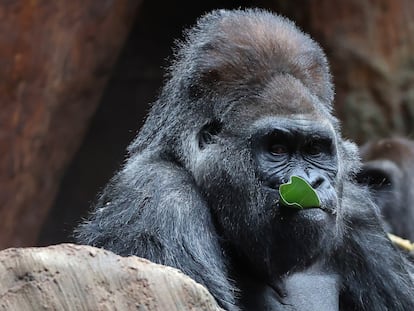Human pathogens like pneumonia, tuberculosis and yellow fever are killing primates
Infection from contact with people is a major threat to the survival of these species

The autopsy determined that Stella’s cause of death was pneumonia. Subsequent tests revealed that the culprit was a human virus, specifically a metapneumovirus. While this virus typically causes a common cold in humans, the chimpanzee named Stella died from it. In 2017, an outbreak of human metapneumovirus killed Stella and 12% of her chimpanzee community in Kibale National Park, Uganda. This doesn’t even take into consideration the orphans who couldn’t survive without their parents.
Respiratory diseases have been the leading cause of death for chimpanzees in Kibale for over 30 years. Similar outbreaks have also affected chimpanzees in Taï National Park (Ivory Coast), Mahale Mountains National Park (Tanzania), and the mountain gorillas in Virunga (Rwanda). A scientific literature review in 2018 documented 33 probable or confirmed cases of pathogen transmission from humans to great apes.
Habitat destruction and human microorganisms have heavily affected wildlife, and even wild chimpanzees now carry bacteria that are resistant to antibiotics. A study conducted in 2021 discovered that chimpanzees in Tanzania’s Gombe Stream National Park have developed resistance to sulfonamides, a type of antibiotic commonly used by local people to treat diarrhea.
However, until recently, primate diseases were not seen as a significant threat to their survival. In the early 2000s, the scientific community primarily focused on the critical issues of habitat loss and poaching, which continue to pose serious threats to primates. Unfortunately, humans still cut down forests — the primates’ main habitat — and hunt wild animals. In this century alone, over 320,000 square miles (600,000 square kilometers) of tropical forest have vanished worldwide, which is equivalent to the entire Iberian Peninsula. In Central Africa, between one and four million tons of bushmeat (wild animal meat) are hunted every year. Twenty years later, the transmission of pathogens from humans to animals (known as reverse zoonosis) is now recognized as a significant threat to primates. Because of their similarity to humans, primates are especially susceptible to this risk.
A scientific literature review conducted in 2022 identified 97 studies that documented instances of reverse zoonosis in wild animals, and 57 of them involved primates. Interestingly, the other animals in the study were predominantly likable species, like elephants and parrots. What does this tell us? According to the literature review authors, this result confirms a strong association between the presence of human pathogens in animals and the level of human contact.
Unfortunately, this is another drawback for primates. The fact that people are willing to pay $1,000 in Rwanda to see gorillas in the wild speaks volumes. Consequently, it’s not surprising that 82% of the infected primate populations were either in captivity or in close proximity to tourists. When properly regulated, ecotourism can generate income that benefits local communities and promotes conservation efforts. However, these studies serve as a cautionary reminder that it can be a double-edged sword.
In 2015, the International Union for Conservation of Nature (IUCN) issued guidelines for managing great ape tourism. The recommendations included wearing masks, limiting the number of tourists per group to eight, restricting observation time to one hour, and maintaining a minimum distance of seven meters between tourists and the animals.
However, a study published in 2020 showed that these guidelines are not being followed. We all enjoy posting about our adventures on the internet. When we go all the way to Uganda and spend good money to see gorillas, we expect to get a great video out of it. The study analyzed social media videos and found that 40% depicted humans getting within one meter of gorillas.
When it comes to captive primates, most recorded outbreaks have been attributed to tuberculosis. Humans naturally host the bacteria responsible for this disease, known as Mycobacterium tuberculosis. However, primates are also highly susceptible, which is why they have long been used as test subjects for studying this disease.
The extent of tuberculosis affecting wild populations is not fully known, but there are confirmed cases. In Taï National Park, researchers performed a routine necropsy on a female chimpanzee killed by a leopard. They discovered that she had tuberculosis, but couldn’t determine if it was a new strain unique to chimpanzees or transmitted from humans.
It is important to note that the authors of the 2022 scientific literature review were conservative in selecting the cases for their study. They only included instances where transmission from humans to animals could be proven. For instance, they chose to exclude diseases transmitted by mosquitoes, like yellow fever. Since yellow fever evolved in Africa about 1,500 years ago, primates have developed a resistance to the disease. But 300 years ago, the slave trade brought yellow fever to America where primates had not developed a similar resistance. Thousands of monkeys have died from yellow fever since then.

One of the most well-known cases is the golden lion tamarin. In the early 1970s, this beautiful primate was on the verge of extinction, with only around 200 individuals left. Fortunately, things started to change when the Mico León Dorado Association established a reserve to protect the golden lion tamarin, and 150 zoos worldwide collaborated on a captive breeding program in the 1980s to reintroduce them to the reserve. The population began to recover, reaching 3,700 individuals in 2014. However, a devastating outbreak of yellow fever in Brazil two years later killed a third of the golden lion tamarin population. It was a tragic setback. Are all these conservation efforts futile? Is there no hope for primates? Should we give up?
No, we should not give up. Conservation efforts have been increasing every year, bringing us hope through small victories. In the 1980s, there were only 300 gorillas left in Rwanda’s Virunga Mountains, but a 2018 census counted 1,063 gorillas. Additionally, scientists adapted the human yellow fever vaccine and initiated a campaign to vaccinate monkeys in the Americas. As our understanding and awareness of these issues grow, it is likely that outbreaks will become less frequent over time.
As the legendary English primatologist Jane Goodall once said, “Whatever we believe about how we got to be the extraordinary creatures we are today is far less important than bringing our intellect to bear on how do we get together now around the world and get out of the mess that we’ve made.”
Sign up for our weekly newsletter to get more English-language news coverage from EL PAÍS USA Edition
Tu suscripción se está usando en otro dispositivo
¿Quieres añadir otro usuario a tu suscripción?
Si continúas leyendo en este dispositivo, no se podrá leer en el otro.
FlechaTu suscripción se está usando en otro dispositivo y solo puedes acceder a EL PAÍS desde un dispositivo a la vez.
Si quieres compartir tu cuenta, cambia tu suscripción a la modalidad Premium, así podrás añadir otro usuario. Cada uno accederá con su propia cuenta de email, lo que os permitirá personalizar vuestra experiencia en EL PAÍS.
¿Tienes una suscripción de empresa? Accede aquí para contratar más cuentas.
En el caso de no saber quién está usando tu cuenta, te recomendamos cambiar tu contraseña aquí.
Si decides continuar compartiendo tu cuenta, este mensaje se mostrará en tu dispositivo y en el de la otra persona que está usando tu cuenta de forma indefinida, afectando a tu experiencia de lectura. Puedes consultar aquí los términos y condiciones de la suscripción digital.
More information
Archived In
Últimas noticias
Venezuela authorizes the release of another 87 political prisoners
There is as much life left to discover on planet Earth as that which is already known
Dozens presumed dead, around 100 injured in fire at Swiss Alps bar during New Year’s celebration
Is porn for women different from conventional porn? We spoke to those who make it
Most viewed
- David King, chemist: ‘There are scientists studying how to cool the planet; nobody should stop these experiments from happening’
- Reinhard Genzel, Nobel laureate in physics: ‘One-minute videos will never give you the truth’
- Oona Chaplin: ‘I told James Cameron that I was living in a treehouse and starting a permaculture project with a friend’
- Sinaloa Cartel war is taking its toll on Los Chapitos
- The Interoceanic Train, the Mexican alternative to the Panama Canal










































